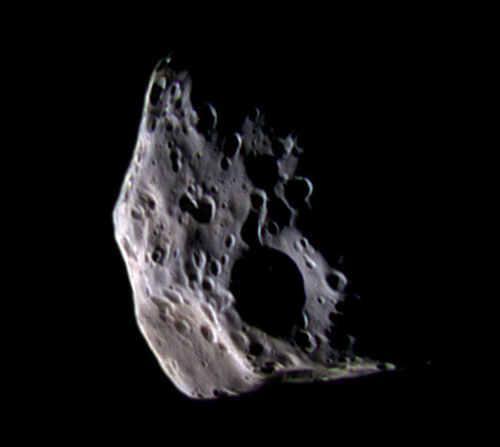Key Takeaways:
Make that a baker’s dozen of new Saturn moons. On May 5, Carolyn Porco of the Space Science Institute in Boulder, Colorado, and leader of Cassini’s imaging team, announced the discovery of another satellite. The spacecraft found the moon, designated S/2005 S 1, in the Keeler gap in the outer part of Saturn’s A ring. The moon orbits Saturn every 0.594 day at a distance of 84,800 miles (136,500 kilometers).
Saturn’s satellite count jumped by 12 moons on December 12, 2004. That night, astronomers Scott Sheppard and David Jewitt of the University of Hawaii and Jan Kleyna of the University of Cambridge (England) discovered a dozen faint blips inching their way around the planet. The moons, designated S/2004 S 7 to S/2004 S 18, all glow at magnitude 24 or 25, about 10 million times fainter than the faintest stars visible to the naked eye.
The astronomers found the new satellites on images taken with the 8.2-meter Subaru Telescope on Hawaii’s Mauna Kea. The team confirmed the objects’ orbital motion in January, February, and March with several Mauna Kea scopes: Subaru, the 8-meter Gemini North, and the twin 10-meter Keck telescopes. Brian Marsden of the International Astronomical Union’s Minor Planet Center then computed orbits for the moons.
All the new satellites lie far from Saturn. The closest, S/2004 S 11, orbits at an average distance of 10.5 million miles (16.9 million km); the farthest, S/2004 S 8, averages 14.7 million miles (23.6 million km) away. In comparison, Saturn’s largest moon, Titan, orbits at a distance of 759,200 miles (1,221,900 km). All except S/2004 S 11 orbit in the direction opposite Saturn’s rotation, a hallmark of wayward asteroids captured by a giant planet’s strong gravity.
The Cassini spacecraft orbits much closer to Saturn than the new moons and so can’t get detailed images of them. But Cassini excels at getting good images of the inner moons. On March 30, it flew within 46,350 miles (74,600 km) of Epimetheus, giving planetary scientists their best view ever.
This moon has an irregular shape, some 72 miles (116 km) across its longest dimension, and lots of soft-edged craters. Spectra taken by Cassini’s visual and infrared mapping spectrometer show the moon’s surface to be composed mostly of water ice. However, Epimetheus’ bulk density falls below that of solid ice, so it likely is what scientists call a “rubble pile” — a collection of numerous smaller pieces held together by gravity.
Epimetheus orbits Saturn at a distance of 94,100 miles (151,400 km), just outside the thin, twisted F ring. It shares an almost identical orbit with a slightly larger moon, Janus. Every 4 years, the two perform an orbital tango when they exchange orbits instead of colliding.
Saturn’s satellite count jumped by 12 moons on December 12, 2004. That night, astronomers Scott Sheppard and David Jewitt of the University of Hawaii and Jan Kleyna of the University of Cambridge (England) discovered a dozen faint blips inching their way around the planet. The moons, designated S/2004 S 7 to S/2004 S 18, all glow at magnitude 24 or 25, about 10 million times fainter than the faintest stars visible to the naked eye.
The astronomers found the new satellites on images taken with the 8.2-meter Subaru Telescope on Hawaii’s Mauna Kea. The team confirmed the objects’ orbital motion in January, February, and March with several Mauna Kea scopes: Subaru, the 8-meter Gemini North, and the twin 10-meter Keck telescopes. Brian Marsden of the International Astronomical Union’s Minor Planet Center then computed orbits for the moons.
All the new satellites lie far from Saturn. The closest, S/2004 S 11, orbits at an average distance of 10.5 million miles (16.9 million km); the farthest, S/2004 S 8, averages 14.7 million miles (23.6 million km) away. In comparison, Saturn’s largest moon, Titan, orbits at a distance of 759,200 miles (1,221,900 km). All except S/2004 S 11 orbit in the direction opposite Saturn’s rotation, a hallmark of wayward asteroids captured by a giant planet’s strong gravity.
The Cassini spacecraft orbits much closer to Saturn than the new moons and so can’t get detailed images of them. But Cassini excels at getting good images of the inner moons. On March 30, it flew within 46,350 miles (74,600 km) of Epimetheus, giving planetary scientists their best view ever.
This moon has an irregular shape, some 72 miles (116 km) across its longest dimension, and lots of soft-edged craters. Spectra taken by Cassini’s visual and infrared mapping spectrometer show the moon’s surface to be composed mostly of water ice. However, Epimetheus’ bulk density falls below that of solid ice, so it likely is what scientists call a “rubble pile” — a collection of numerous smaller pieces held together by gravity.
Epimetheus orbits Saturn at a distance of 94,100 miles (151,400 km), just outside the thin, twisted F ring. It shares an almost identical orbit with a slightly larger moon, Janus. Every 4 years, the two perform an orbital tango when they exchange orbits instead of colliding.











